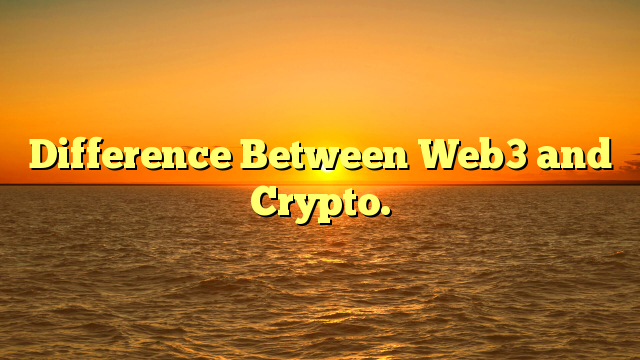Difference Between Web3 and Crypto.
The digital landscape is undergoing a revolutionary shift. At the forefront of this change lie two enigmatic terms: Web3 and crypto. While both are intertwinwith the world of blockchain technology, their purposes and applications differ significantly. Understanding these distinctions is crucial for navigating the complexities of the emerging decentralized future.
Meaning and Definition of Web3 and Crypto:
Web3: The Decentralized Dream
Web3 envisions a new iteration of the internet, one liberated from the control of centralized authorities like tech giants. It strives for a more democratic and user-owned online experience. Here’s how it breaks down:
Decentralization: Web3 applications (dApps) operate on peer-to-peer networks, eliminating the need for intermediaries. Data and ownership reside with users, not corporations.
Openness: Web3 protocols are built on open-source code, fostering transparency and community collaboration.
User Empowerment: Web3 empowers users with greater control over their digital identities and data. They can interact directly with applications and services without relying on centralized platforms.
Crypto: The Currency of the New Web
Cryptocurrencies, on the other hand, are digital assets built on blockchain technology. They serve as a medium of exchange, a store of value, and sometimes, a unit of account in the digital realm. Key characteristics of cryptocurrencies include:
Decentralization: Similar to Web3, cryptocurrencies operate on decentralized networks, removing the need for central banks or institutions for issuance and management.
Security: Cryptocurrencies leverage cryptography to ensure secure transactions and prevent tampering.
Transparency: Blockchain technology provides a transparent and immutable record of all transactions on a cryptocurrency’s network.
The Overlap: Blockchain – The Unifying Force
Both Web3 and crypto rely heavily on blockchain technology. Blockchains are distributed ledgers that securely store and record data in a way that is transparent, tamper-proof, and auditable. This technology forms the foundation for the decentralized nature of both Web3 and crypto.
Top 10 Ways Web3 Will Change the Internet
Web3 promises to reshape the online landscape in numerous ways. Here are ten key areas of transformation:
1.Data Ownership: Web3 empowers users to own and control their data, allowing them to decide how it’s used and monetized.
2.Decentralized Finance (DeFi): Web3 facilitates the creation of DeFi applications, enabling peer-to-peer financial services without traditional intermediaries.
3.The Rise of dApps: Web3 fosters the development of dApps, which offer a wider range of functionalities and greater user control compared to traditional web applications.
4.The Creator Economy: Web3 empowers creators to connect directly with audiences and monetize their work more effectively through platforms like NFTs (Non-Fungible Tokens).
5.Gaming Revolution: Web3 paves the way for “play-to-earn” games, where players can own in-game assets and potentially earn rewards through their participation.
6.Decentralized Social Media: Web3 opens doors for censorship-resistant social media platforms, where users have more control over their content and online interactions.
7.Supply Chain Transparency: Web3 can revolutionize supply chains by providing transparent and immutable records of product provenance.
8.Identity Management: Web3 fosters the creation of self-sovereign identities, allowing users to control their digital identities without relying on centralized authorities.
9.The Sharing Economy: Web3 facilitates the development of decentralized sharing economy platforms, enabling peer-to-peer resource sharing and collaboration.
10.Governance and Voting: Web3 can reshape governance by enabling more transparent and democratic voting systems.
How to Get Started with Web3 and Crypto
Intrigued by the possibilities of Web3 and crypto? Here’s how to take the first steps:
-Educate Yourself: Familiarize yourself with the core concepts of blockchain, Web3, and cryptocurrencies. Numerous online resources and educational platforms can guide you.
-Choose a Wallet: Secure a crypto wallet to store your digital assets. There are various options available, from hardware wallets for enhanced security to software wallets for convenience.
-Explore Crypto Exchanges: Research different cryptocurrency exchanges to safely buy and sell cryptocurrencies.
-Engage with dApps: Once comfortable with the basics, delve into the world of dApps. Explore different categories like DeFi, gaming, and social media to discover applications that align with your interests.
Stay Informed: Keep yourself updated on the latest developments in Web3 and crypto. Follow reputable news sources and communities to stay ahead of the curve.
Web3 and Crypto: Recent News and Developments
The Web3 and crypto space is constantly changing. Here are some recent headlines:
Metaverse Mania: The idea of a decentralized metaverse, a virtual world powered by Web3 technologies, is gaining significant traction. Major tech companies and startups are investing heavily in building these immersive experiences.
DAOs on the Rise: Decentralized Autonomous Organizations (DAOs) are emerging as a new form of collective ownership and governance. These internet-native communities leverage blockchain technology to make collaborative decisions.
Regulation in Focus: Regulatory bodies worldwide are scrambling to develop frameworks for governing the crypto and Web3 landscape. This regulatory scrutiny, while essential, can also pose challenges for innovation.
The NFT Boom Continues: Non-Fungible Tokens (NFTs) continue to capture headlines, with new use cases beyond digital art emerging. From tokenized real estate to fractional ownership of collectibles, NFTs are disrupting traditional asset classes.
Scalability Challenges: Scaling blockchain networks to handle a larger user base remains a pressing issue. Developers are exploring various solutions, including layer-2 scaling protocols and proof-of-stake consensus mechanisms.
Statistics in Web3 and Crypto:
While the Web3 and crypto space is brimming with excitement, it’s important to ground your understanding in some relevant statistics:
Global Blockchain Market Size: According to Market Research Reports, the global blockchain market size is projected to reach a staggering $67.4 billion by 2026, indicating significant growth potential.
Crypto Adoption: A Statista report reveals that over 300 million people globally now own cryptocurrency, highlighting the growing user base.
DeFi Market Value: DeFi, a key pillar of Web3, has witnessed explosive growth. According to CoinMarketCap, the total value locked (TVL) in DeFi protocols surpassed $200 billion in early 2024.
NFT Market Growth: The NFT market has undergone a meteoric rise. DappRadar statistics indicate that NFT trading volume exceeded $25 billion in the first quarter of 2024 alone.
Conclusion: Navigating the Future with Web3 and Crypto
The rise of Web3 and crypto presents both opportunities and challenges. Understanding the distinctions between these concepts is essential for making informed decisions in this rapidly evolving space. By educating yourself, exploring the possibilities, and staying informed about the latest developments, you can position yourself to participate in the shaping of the decentralized future.


3 thoughts on “Difference Between Web3 and Crypto.”